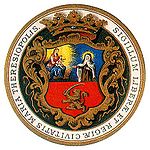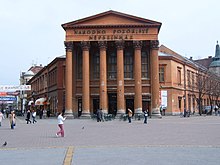Subotica
|
Суботица Subotica Szabadka |
||||
|
||||
| Basic data | ||||
|---|---|---|---|---|
| State : | Serbia | |||
| Province : | Vojvodina | |||
| Okrug : |
Severna Backa |
|||
| Opština : | Subotica | |||
| Coordinates : | 46 ° 6 ' N , 19 ° 40' E | |||
| Height : | 109 m. i. J. | |||
| Area : | 290.0 km² | |||
| Residents : | 105,681 (2011) | |||
| Agglomeration : | 141,554 (2011) | |||
| Population density : | 364 inhabitants per km² | |||
| Telephone code : | (+381) 024 | |||
| Postal code : | 24,000 | |||
| License plate : | SU | |||
| Structure and administration (as of 2016-) | ||||
| Community type: | city | |||
| Structure : | 16 boroughs | |||
| Mayor : | Bogdan Laban (Srpska Napredna Stranka) | |||
| Postal address : | Trg slobode 1 24000 Subotica |
|||
| Website : | ||||
| Others | ||||
| Patron saint : | St. Rochus | |||
Subotica [ ˈsûbɔtitsa ] ( Serbian - Cyrillic Суботица , ; German name 1740–1918 Maria Theresiopel ; Hungarian Szabadka [ ˈsɔbɔtkɔ ]) is the second largest city in Vojvodina and the fifth largest city in the Republic of Serbia with 105,681 inhabitants . It is the capital of the Opština Subotica of the same name , the northernmost Opština in Serbia, and the administrative center of the Severna Bačka district . Subotica is located ten kilometers from the Hungarian border. The region around the city is very fertile and known for intensive agriculture . The food industry is an important branch of the economy .
Before the First World War , Subotica was a territorial part of the dual monarchy Austria-Hungary and was called Maria-Theresiopolis (so still today in the official coat of arms) or Maria-Theresiopolis . With the end of the war, the city came to the newly created Kingdom of Serbs, Croats and Slovenes , which was confirmed with the Treaty of Trianon in 1920 . Subotica was the second largest city in Serbia after it was incorporated into Serbia.
geography
Subotica is located in the Pannonian Plain . There is a temperate continental climate with the four seasons common in Europe .
Thanks to its geographical location, it became a regiopolis for the surrounding area.
The city is on Europastraße 75 . This connects them in the north with Szeged in Hungary and in the south with Novi Sad , the capital of Vojvodina. Further south you come to the Serbian capital Belgrade . A single-lane non-electrified 43 km long railway line ( railway line Szeged – Röszke – Subotica ) leads to Szeged (Hungary).
structure
The city is divided into 16 districts . However, these have no municipal status, such as the municipalities of Belgrade or Niš .
Origin of name
The name Subotica is derived from the Serbian word for Saturday , Subota , and first appeared in 1653. The Croatian and Serbian word for Saturday is Subota , so Subotica means “Saturday” or “little Saturday”. Another thesis says that the name of the city is derived from Subota Vrlić . Subota was the treasurer of Emperor Jovan Nenad in the 16th century .
There have been almost two hundred different names for the city of Subotica in history. This is because the city, like Vojvodina, belonged to many different empires and states. In addition, different peoples settled on the current location of the city and gave it a name in their own language.
The earliest known record of the city's name is Zabadka and dates back to 1391. This is also the origin of the Hungarian version of the name Szabadka . But it was not until 1679 that the name appeared in the current spelling. The Hungarian name of the city is derived from the adjective szabad , meaning “free” or “independent”, and the suffix -ka , which is a diminutive form . Thus the earliest name means something like free or independent town .
In 1740 the city was renamed in honor of Maria Theresa of Austria . The city was officially called Szent-Maria in 1743 . But already in 1779 it was renamed Maria-Theresiapolis again.
In the other three official languages of Vojvodina , the city is called the same as in Serbian: Subotica in Slovak , Суботица in Yugoslav-Russian and Subotica or Subotiţa in Romanian .
population
| Population development | |
|---|---|
| year | Residents |
| 1850 | 48.126 |
| 1869 | 57,556 |
| 1880 | 62,555 |
| 1890 | 74,250 |
| 1900 | 82,235 |
| 1910 | 93,232 |
| 1921 | 90.961 |
| 1931 | 100.058 |
| 1948 | 63,079 |
| 1953 | 66.091 |
| 1961 | 75,036 |
| 1971 | 88,813 |
| 1981 | 100,516 |
| 1991 | 100,386 |
| 2002 | 99,981 |
Population development
Before Subotica was conquered by the Ottomans in the 16th century, the city was largely inhabited by Magyars . However, during the Ottoman rule, the city recorded more Serbs than Magyars. From the end of the 17th century to the middle of the 19th century, Subotica was increasingly populated by Bunjewatzen . In 1868 there were still 50,000 Bunjewatzen, 6,000 Magyars, 3,500 Serbs and 1,300 Jews living in Subotica . Slovaks and Danube Swabians also lived in the city. According to counts in what was then Austria-Hungary at the end of the 19th century and in the first years of the 20th century, the Hungarian language was more widespread than the language of the Bunjewatzen at that time . However, it is still not clear whether the Magyars or the Bunjewatzen made up the majority at that time. In the Kingdom of Hungary , counting was not based on ethnic background, but based on the native language of the respective inhabitant. Budapest's policy towards the Slavic minority also had a major impact on the census, because the majority of the Bunjewatzen spoke Slavic languages or had been Magyarized , giving them Hungarian as their mother tongue.
Before the First World War , the city had 93,232 inhabitants. With 55,587 inhabitants, the Magyars still made up the majority, followed by the Bunjewatzen with 33,247 inhabitants. With the end of the war, the city came to the newly created Kingdom of Serbs, Croats and Slovenes , which was confirmed in 1920 with the Treaty of Trianon . As a result, Serbs increasingly moved to Subotica. The flight of the Magyars made itself felt as early as 1921. While in 1921 there were still 26,750 Magyars resident in Subotica, the number of Serbs increased to 60,700.
With the beginning of the Second World War and Hungary's endeavors to re-annex its lost territories, the number of Magyars rose to 61,581 (59.93%). Many Slavs and Jews were persecuted or were to Croatia in concentration camps accommodated. At the first census after the establishment of the SFRY in 1953, Subotica had 66,091 inhabitants, of whom 32,194 were Magyars (50.6%). At that time, the Bunjewatzen could not indicate their ethnicity. Anyone who did it anyway was registered as a Croat.
In the following years until the beginning of the Yugoslav wars , the population increased continuously. In 1991 a large number of Croatians fled Subotica under the Milošević regime. The attacks of the Yugoslav People's Army on Croatia and the Croats in Vojvodina at the time are the main factor behind the decline.
Ethnic composition
Hardly any other city in Serbia is as multi-ethnic as Subotica. The city owes this to its eventful history, but also to its location as an important point for traffic between Central and Southeastern Europe and the Middle Ages. In the last census of 2011, the city together with Palić had a total of 105,681 inhabitants. At that time, divided by nationality, there were 34,511 (32.7%) Magyars , 31,558 (29.9%) Serbs , 9,698 (9.2%) Croats , 9,236 (8.7%) Bunjewatzen and 2,728 (2.6%) named themselves than Yugoslavs . Roma made up 2.5% of the population, a total of 2,586 inhabitants.
The city is a regional center for the Magyars, Bunjewatzen and Croats in Vojvodina. In addition, Subotica is the city with the most self-declared Yugoslavs in Serbia.
In the 1980s, Subotica was known as the city of ethnic tolerance .
languages
69,155 of the population speak Serbian , followed by Hungarian (57,608) and Croatian (8,806). A total of 50.53 percent of the population speak South Slavic languages .
The Serbian language is the most widely used language in everyday life. The Hungarian language is also used by almost a third of the population in their daily conversations. Both languages are also widely used in commercial and official signage.
history
The first written mention of Subotica dates back to 1391. From 1542 to 1686 it was under Turkish suzerainty. In the Kingdom of Hungary and later in Austria-Hungary , the city called Maria-Theresiopel (Maria-Theresienstadt) since 1779 was the third largest of the Hungarian part of the Empire, after the First World War it came to the Kingdom of Serbs, Croats and Slovenes ( Yugoslavia , see Treaty of Trianon ). From 1723 to 1726 the Serbian Orthodox Church of the Assumption of Christ was built in the city center of Subotica .
politics
flag and emblem
The flag of the city of Subotica is a white and blue bicolor with the city's coat of arms in the center.
During the Second World War , Subotica was under Hungarian rule . The flag was changed accordingly. It was now a blue-red bicolor with a yellow , vertical line in the middle. Such simple flags were used all over Hungary at that time. Nothing is known about the use of the flag.
The city's coat of arms has been in use since September 1, 1779. At that time, the city was given the rights of a free, royal city and it was renamed Maria-Theresienstadt . The coat of arms is round, and there is writing on the white, outer stripe: Sigillum Liberæ et Regiæ Civitatis Maria Theresiopolis . The upper part of the shield , which is located in the middle of the coat of arms, is supposed to represent today's modern city. The lower part consists of a red background and a golden lion with a sword .
Twin cities
Subotica is twinned with the following cities:
-
 Budapest , Hungary
Budapest , Hungary -
 Szeged , Hungary
Szeged , Hungary -
 Kiskunhalas , Hungary
Kiskunhalas , Hungary -
 Wolverhampton , UK
Wolverhampton , UK -
 Dunajská Streda , Slovakia
Dunajská Streda , Slovakia -
 Olomouc , Czech Republic
Olomouc , Czech Republic -
 Odorheiu Secuiesc , Romania
Odorheiu Secuiesc , Romania -
 Elche , Spain
Elche , Spain -
 Namur , Belgium
Namur , Belgium -
 Tilburg , Netherlands
Tilburg , Netherlands -
 Osijek , Croatia
Osijek , Croatia -
 Treptow-Koepenick district of Berlin, Germany
Treptow-Koepenick district of Berlin, Germany -
 Petah Tikva , Israel
Petah Tikva , Israel
economy
Subotica is one of the most important economic centers in Serbia. This applies to both industry and agriculture and the food processing and refinement based on them. Due to its favorable geographical location and its transport connections, Subotica is an important trading and transshipment center. In addition, Subotica is home to one of the three Serbian special economic zones .
As the first city in Vojvodina, Subotica was given a military area (the former so-called Barracks II) for independent conversion into an industrial park in autumn 2009. By summer 2010, 21 hectares of new urban industrial space will be created.
In March 2012, it was announced that the city had signed a contract for the assignment of land to the company D. Swarovski . In the first phase, Swarovski is planning to build a 15,000 square meter production hall there. The total cost of the project is estimated at 21 million euros. By 2016, 550 people should find work in the new factory.
Culture
architecture
Most of the buildings in Subotica were built in the Art Nouveau style. These include the town hall , which was built between 1908 and 1910, and the synagogue , which was built in 1902 . These two buildings were designed by the architects Marcell Komor and Dezsõ Jakab from Budapest.
Other important buildings are:
- the Catholic Cathedral of St. Teresa of Ávila (built in 1797) and the Chapel of St. Rochus
- the Franciscan monastery (built in 1723)
- the Orthodox churches (also built in the 18th century )
- the synagogue from the fin de siècle
The restoration of the synagogue has started in recent years. By 2004, more than 400,000 US dollars accepted donations.
theatre
The city's historical theater , built in 1854 as the first monumental public building in Subotica, was demolished in 2007, although it was declared a historical monument under state protection from 1983 to 1991. The national register lists the theater as a monument of exceptional cultural value. An international campaign to save the historic building was launched in both Serbia and Hungary, but to no avail. ICOMOS and INTBAU also protested against the demolition of the building.
After the demolition, the National Theater was partially rebuilt based on the original building.
Newspapers
The following newspapers are published in Subotica:
- Subotičke novine , a weekly newspaper in Serbian
- Magyar Szó , in Hungarian, has been published in Subotica since 2006
- Bunjevačke novine , in Bunjevacian language
- Hrvatska riječ , in Croatian
Movie
In 1955 the film I often think of Piroschka with Liselotte Pulver was shot here.
Personalities
- Bálint Kuzsinszky (1864–1938), Hungarian archaeologist
- Dezső Kosztolányi (1885–1936), Hungarian writer
- Géza Csáth (1887-1919), Hungarian writer
- Sylvester Matuska (1892–1944 / 45), railway bomber
- Josef Gerö ( 1896–1954), Austrian lawyer, politician and sports official
- Tibor Sekelj (1912–1988), Yugoslav world traveler and writer
- Aleksa Kokić (1913-1940), Croatian writer
- Albe Vidaković (1914–1964), Croatian composer
- Juci Komlós (1919–2011), Hungarian actress
- Vilim Harangozo (1925–1975), table tennis player
- Josip Gabrić (* 1930), table tennis player
- Andrija Fuderer (1931–2011), chess player
- Yehuda Elkana (1934–2012), Israeli historian of science
- Danilo Kiš (1935–1989), writer
- Anton Rudinski (1937–2017), football player and coach
- Sylvester Levay (* 1945), Hungarian composer
- Bela Mesaros (* 1952), table tennis and chess player who lives in Subotica
- Rudolf Klein (* 1955), architect and university professor
- Zoran Kalinić (* 1958), table tennis player
- Zoran Janjetov (* 1961), comic artist
- László Keszég (* 1970), Hungarian actor and director
- Božidar Đurković (* 1972), football player
- Péter Lékó (* 1979), Hungarian chess player
- Before that, Štefanek (* 1985), wrestler
- Vojislava Lukić (* 1987), tennis player
- Nenad Beđik (* 1989), rower
- Thea Soti (* 1989), Hungarian musician
- Ivan Sabanov (* 1992), Croatian tennis player
- Matej Sabanov (* 1992), Croatian tennis player
photos
Monument to Tsar Jovan Nenad
See also
Sources and references
- ↑ a b Evaluation of the censuses on the territory of today's Republic of Serbia from 1948 - 2011 (PDF; 61.2 MB). Statistics Office of the Republic of Serbia. Published April 2014. Accessed July 24, 2014.
- ↑ Veselin Dželetović Pavlov: Последњи српски цар Јован Ненад . Gora pres, Belgrade 2007, ISBN 978-86-86863-00-3 , p. 133 .
- ^ The History of Subotica , City of Subotica.
- ↑ Становништво, упоредни преглед броја становника 1948, 1953, 1961, 1971, 1981, 1991, 2002, подаци по насељикима, Репуб засељикима, Репуб . May 2004.
- ↑ 2011 census, results.
- ↑ The Use of Hungarian and Serbian in the City of Szabadka / Subotica: An Empirical Study. Retrieved September 8, 2017.
- ↑ "Svarovski dobrodošao u Srbiju" , b92.net, March 21, 2012
Web links
- Official website of Subotica
- Economic development Subotica with information about the city (multilingual)
- Ferdinand, S. and F. Komlosi. 2017. The Use of Hungarian and Serbian in the City of Szabadka / Subotica: An Empirical Study , Hungarian Cultural Studies, Volume 10. Accessed September 8, 2017.









